A room can be called residential only if there is a comfortable, that is, positive temperature in it. And its achievement, especially in a short period, is sometimes a very troublesome business, even with special means, such as an electric fireplace, an air conditioner. The best solution, especially for industrial, large-scale premises, is a heat gun, which can quickly raise the temperature highly efficiently. The editorial staff of the site "bestx.htgetrid.com/en/" offers to your attention a rating of high-quality heat guns for 2020 with their detailed characteristics, taking into account the power, advantages and disadvantages.
Content
What is a heat gun
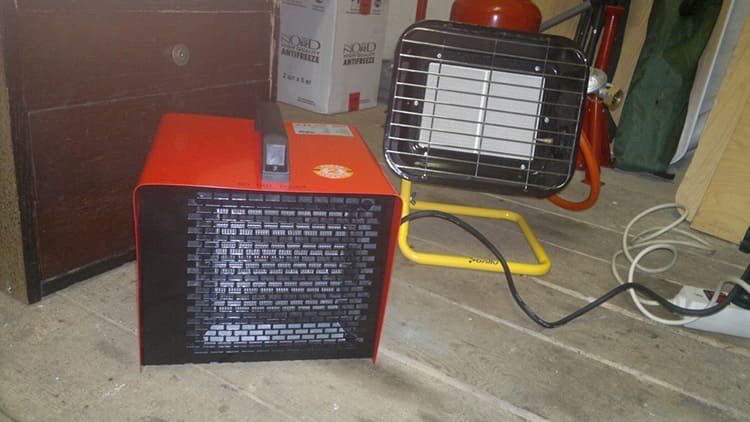
In fact, its TP consists of three parts: a heating element (NE), a fan and a case. The principle of operation of such a device is extremely simple, the fan, while working, displaces the air masses heated by the NE, warming up the room. The fan is driven by electricity, but the NE works in different ways. Depending on what type of heating element is used, heaters are divided into:
- Gas;
- Diesel;
- Electrical;
- Multi-fuel.
More complex devices also have a power regulator, a temperature sensor. With the help of the first one, the temperature of the NE is regulated, the temperature sensor allows maintaining the set temperature in automatic mode. In addition, a number of models have built-in thermal relays that protect the device from overheating, fuel volume indicators.
Despite the structural difference in the principle of operation, regardless of their size and purpose, all guns have significant technical characteristics, such as:
- power;
- air flow mass;
- distance, its direct impact;
- the amount of noise produced;
- fuel consumption;
- time of continuous work;
- dimensions of the device.
Each of the parameters should be described in more detail.
Power
The main parameter of all heat guns, on which the temperature generated by it depends, the price of the device, its dimensions.
Before buying a gun, you should calculate this parameter as accurately as possible. After all, if the power of the device is excessive, it will directly affect the price of the device.
The parameter is calculated according to the formula Q = k * V * T. Where k is the coefficient of thermal conductivity of walls, windows of the room, V is its volume, T is the temperature difference. Before calculating, some nuances of the formula should be mentioned. For example, the value of the thermal conductivity coefficient is inversely proportional to the quality of the finish. Older, single framed panel buildings may have show - 3 units. A room with good insulation, double glazing has a number of 0.6 to one. Further, the volume of the room should not be confused with its area. The volume is calculated from the area multiplied by the ceiling height.
Let's assume that the area of the room is 10 sq. m with a ceiling height of 2.5 meters, walls, windows are sufficiently insulated, so they can be taken as a unit.Outside temperature: -15, required temperature: +20, which is quite enough for a non-residential room or utility block. As a result, we get the amount of 1225 kcal / h. One watt is 860 kcal / h, so dividing 1225/860, we get 1.4 kilowatts. As a rule, the power is chosen a little more than the obtained formula, therefore, having rounded up, we can choose a TP with a power of 1.5 kilowatts. Such devices with indicators up to 5 kW are called household ones, in relation to electrical TP, this means a possible connection to a conventional power grid.
For the convenience of calculating this parameter, below is a table of the recommended capacity in relation to various types of buildings at an external temperature of -30 degrees.
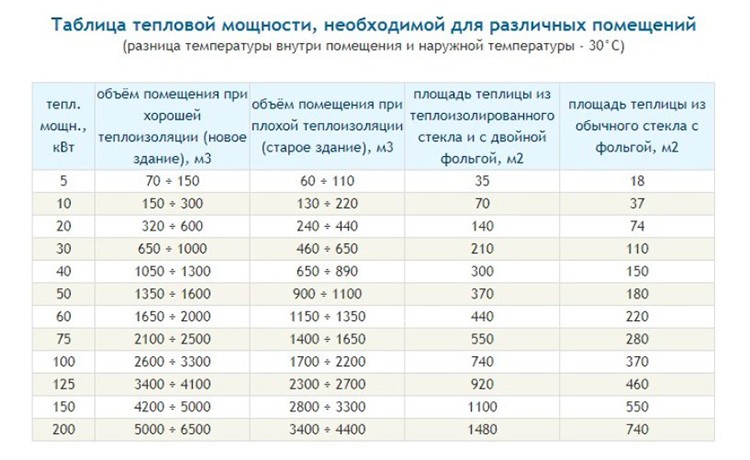
Air flow mass
This parameter depends on the strength of the fan, the larger the air mass, the faster and more efficiently the area will warm up without overheating the device itself. At the same time, the energy consumption will increase accordingly, the noise produced by the fan will increase.
Air flow distance
A quantity that is directly proportional to the air flow. It shows the length of the heated air jet generated by the fan. It depends not only on the number of fan revolutions, but also on the configuration of the device itself. In addition, IR guns do not have a blade fan at all, but they heat up at a much greater distance than conventional models, without making a lot of noise. How infrared TP works, we will analyze below.
Time of continuous work
How long the heater can work depends on the volume of the tank, if the diesel model - on the type of heater. One way or another, but not a single device can work around the clock, the instructions for it will necessarily indicate the rest time, the frequency of the cycles.
Noisiness
Where the workshops and hangars are located, this parameter is probably not so important, but for domestic use it is worth paying attention to.
The amount of noise produced depends on the same fan, on the type of device. So diesel heaters are much more noisy than gas, electric ones. The most "silent" infrared guns.
Consumed energy
Any device must receive energy from any source, electricity, diesel, gas. Accordingly, its consumption will determine the cost of heating the site. It is also important to have the ability to connect a gun for electricity and gas consumption.
Moreover, electric industrial guns require a voltage of 380 volts.
Overall dimensions
Another important factor in household services. After all, the heater should be located as efficiently as possible so that the heated air stream evenly warms up the room, but the heater itself should not interfere with movement around the room, but should be at a safe distance from children and animals. Naturally, the larger the dimensions of the device, the more difficult it is to fulfill all these conditions due to the low mobility of the heating device.
It should be borne in mind that some guns have an auto-rotate function for which you also need to have a certain stock of square meters. Therefore, when choosing the location of the TP, you should decide on its size, whether it will be a stationary, mobile type.
Types of heat guns
After you have calculated the main parameters, determined the dimensions of the noise produced, you should familiarize yourself with the possible types of their device.
Electrical TP
The most popular models of heat guns. An excellent choice for a country house or apartment. The popularity of models is determined by such factors as a wide range of prices, the ability to connect to any point equipped with an outlet, the completeness of choice in terms of power and dimensions.
They are both stationary and portable, of various types of fastening, for example, floor, wall.
The advantages of this type of heater:
- Lack of exhaust gases, harmful emissions, which allows them to be used in the presence of people, animals;
- High operational versatility makes it possible to heat almost any room;
- No need for complex assembly or installation of exhaust pipes;
- Long time of uptime;
- Starting at subzero temperatures;
- No fuel required;
- Operational safety.
Disadvantages:
- The need for an electrical network designed for the current consumption of the device;
- The high price of electricity in comparison with other types of fuel;
- Limited use in rooms with high humidity;
- Mobility is limited by the length of the cord.
Gas TP
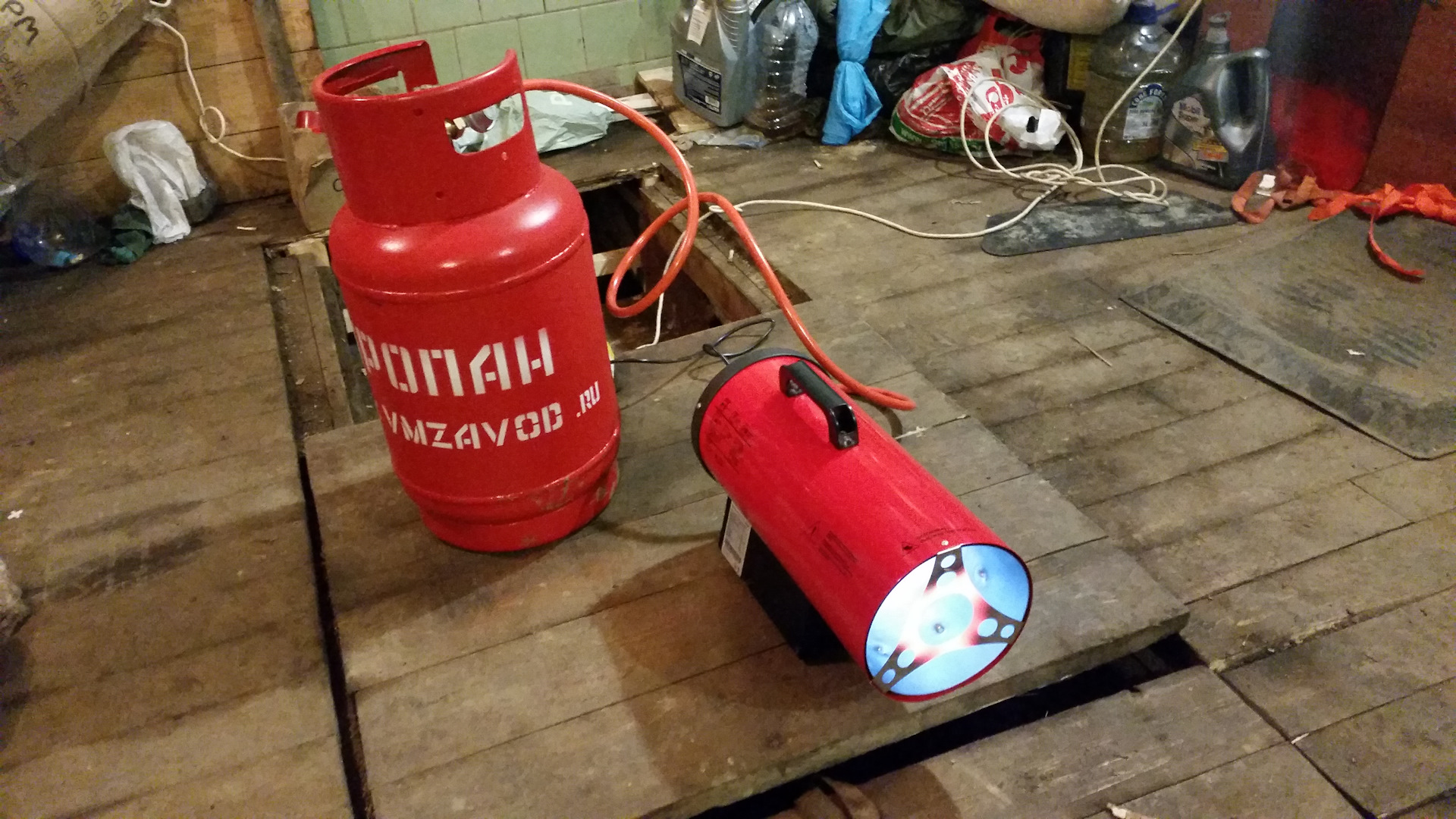
These heaters work by heating the NE with gas supplied either through a gas pipeline or through a cylinder.
But the fan is driven in the same way by electricity, albeit with a small current consumption. That is, a source of electricity is still needed. Also, such heaters have a rich functionality that allows the device not to overheat, automatically tracks the burning of the flame.
Taking into account these qualities, as well as the low cost of operation, gas heat guns are often used for repair work, for example, for stretch ceilings, or, when it is required evenly, to quickly dry a freshly painted hangar wall, a plastered surface.
The advantages of this type of heater:
- Low operating cost;
- Best to show efficiency;
- Almost immediate heating of the room;
- A large number of functionalities;
- Warming up uniformity.
Disadvantages:
- Attachment to a gas pipeline or gas cylinder;
- The need for a source of electricity;
- During operation, regular ventilation of the room or chimney is required.
Diesel TP
This type of device is of three types, direct, indirect, infrared radiation.
The first two are the simplest, in them diesel fuel, burning, generates heat, which, like in other guns, is distributed by a fan. The only difference is that the first, direct action, do not have a chimney, so the fan carries out the combustion products along with the heat. It is strictly forbidden to use such guns in rooms where people are. But such a heat gun or heater is ideal for a warehouse or premises without the presence of people.
Indirect heating devices have a waste gas outlet, so their operation is possible if a reliable chimney system is provided. In this case, they can be limited, they can be used in rooms with people, for example, how to heat for a greenhouse.
The advantages of this type of heater:
- High performance;
- Ideal cost of ownership when producing large buildings;
- With a timer, temperature control system, complete autonomy.
Disadvantages:
- The need for fuel storage;
- Requires periodic refilling of fuel into the tank;
- Even in the case of indirect action, the presence of people in the room is limited and not safe.
Infrared guns have no fan, which makes them almost silent. Heating takes place by means of an infrared source. It, in turn, heats up, burning fuel, after which the infrared rays pointwise affect the objects in the room, furniture, the wall, heating them. Those give off warmth to the room. That is, heating occurs not directly with a gun, but through the heating of the surrounding objects.
The advantages of this type of heater:
- Minimal noise;
- Rapid heating of objects, walls of the room;
- High mobility;
- High level of security;
- Suitable for outdoor use, open construction sites.
Disadvantages:
- Poor, slow heating of the room as a whole;
- High price.
Multi-fuel TP
Their principle of operation, pros, cons are exactly the same as those of the diesel TPs described above. The only difference is in the type of fuel consumed. This can be diesel fuel, kerosene, gasoline, waste engine oil.
Ideal for garage, auto repair shop. That is, where there are residues of fuel and oils that are problematic to dispose of.
Water heaters
Often, water cannons or, as they are mistakenly called, water heat guns, come across in the ratings of guns. In fact, this class of technology has nothing to do with heat guns. After all, TPs are mostly autonomous, mobile devices. Water cannons, in addition to being bound to an energy source, depend on the water supply, and the type of their placement is wall-mounted, so it is impossible to move them.
The main manufacturers of this equipment
Since we are not talking about a simple air heater, but about a device potentially hazardous to health, whose price can be quite significant, an important point of the article will be - which company would be better to buy a heat gun?
- Ballu
It is best to start acquaintance with manufacturing firms with the most famous brand that produces popular household appliances - Ballu. Those who have ever come across climatic technology are familiar with this company. Its distinctive feature, excellent workmanship, thoughtful details, technical characteristics at the highest level.
If there is a need for a proven, safe technique, you should turn your attention to Ballu. Let the products of this company be more expensive than other manufacturers.
- FUBAG
Products from FUBAG have always been the leaders in the segment of diesel, gas heaters. The company is famous not only in its homeland, in Germany, its equipment is popular all over the world, including thanks to a two-year warranty.
- Master
An American company that produces the entire range of heat guns, including small, budget models with a capacity of several kilowatts and industrial units. Solid and "experience" of the company, more than 60 years in the market of climatic technology!
- Timberk
The main direction of Timberk is economical, cost-effective equipment, whose parameters sometimes differ significantly, for the better, from competitors. Therefore, if the question - how much electricity, fuel the heat gun consumes - is urgent for you, we recommend that you pay close attention to the products of this company.
- Inforce
A domestic manufacturer of instrumental and heating equipment, which creates it as much as possible adapted to working conditions in our climate, taking into account our operating characteristics (mains voltage drop, fuel purity). The quality of the manufactured equipment is at a high level.
- Resanta
Relatively young, more than 25 years of experience in manufacturing, various equipment, construction, electrical and heating purposes, Latvian manufacturer. The European quality of technology is comfortably combined with a low price due to its close proximity.
What to prefer
The main criteria for choosing heat guns are safety, device power, its price, maintenance cost. If you need a heater for a summer cottage, for example, during its de-preservation after a winter downtime, then, oddly enough, the gas model would be the best choice. After all, the house was unattended for a long time, so no one can guarantee the serviceability of the electrical network. With a gas heater, operating from a cylinder, it is possible to warm up a greenhouse and living quarters in case of sudden frosts.
But in the presence of high-quality wiring, a fuse box, mounted according to all the rules, it is permissible to install an electric gun, even of a middle performance class.
When choosing diesel vehicles, you should not save on money, because trouble-free work with such guns is above all.
In addition, inexpensive diesel engines allow metal to burn out near the burner, so specimens with thin iron will not last long.
Low-power installations
ELITECH TP 3EM
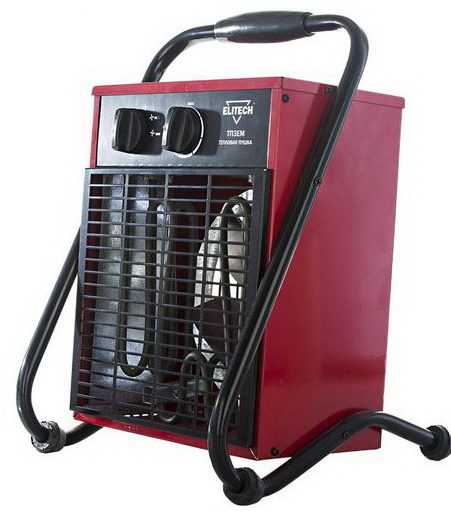
A very interesting device with broad capabilities at a low price.The base of TP 3EM is classic, with a ceramic heating element, which gives a low cost price for long-term operation of the device. Among the advantages of TP 3EM is the possibility of autonomous operation, the case is not afraid of high levels of moisture. This makes it possible to use TP 3EM for car wash, cellar drying. Moreover, it is allowed to operate one fan without turning on the NE.
| Model | ELITECH TP 3EM |
|---|---|
| NE type | Electric |
| Max. Power | 3 kW |
| Heating area | up to 35 sq / m |
| Outgoing air exchange | 300 m³ / hour |
| Control type | Mechanical |
| Dimensions (width, height, depth cm, weight kg) | 29x42.5x34.5cm, 6.5kg |
| Additional functions | Overheating shutdown |
| Fan operation without NE |
Advantages:
- Decent functionality;
- Moisture resistance;
- Durable body;
- Class-appropriate price.
Disadvantages:
- Performance is poor;
- High noise level;
- Quite a large mass.
Ballu BHP-P-3
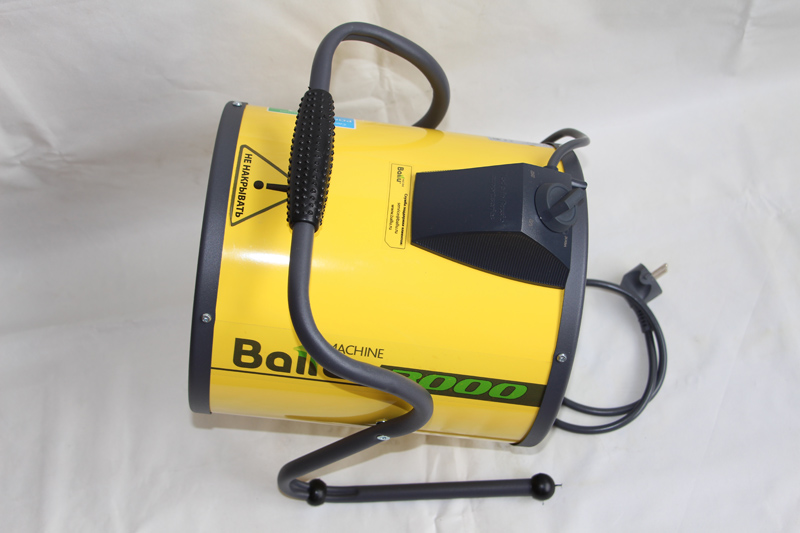
A simple, reliable in operation model of an electric oven with a budget-level thermostat. Its safety is ensured by the rounded double-walled body. Ergonomics allows the device to be adjusted relative to its base so that warm air masses warm up the space as evenly as possible.
The mobility of the BHP-P-3 is provided by the handle on the body.
| Model | BHP-P-3 |
|---|---|
| NE type | Electric |
| Max. Power | 3 kW |
| Heating area | up to 35 sq / m |
| Outgoing air exchange | 300 m³ / hour |
| Control type | Mechanical |
| Dimensions (width, height, depth cm, weight kg) | 38.5x29x31.5 cm, 4.8 kg |
| Additional functions | Power adjustment |
| Fan operation without NE |
Advantages
- Robust, durable housing;
- Low price;
- Work safety.
disadvantages
- Short cord.
BALLU BHP-M-3
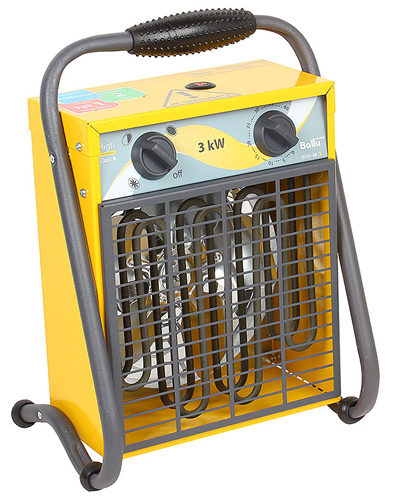
A low-power household heater that can work for a long time without interruption. Easy to start at low temperatures, providing a uniform blowing of warm air around the entire perimeter of the area. High-quality, wear-resistant material of manufacture BHP-M-3, protective functions, ensure a long and trouble-free operation.
| Model | BHP-M-3 |
|---|---|
| NE type | Electric |
| Max. Power | 3 kW |
| Heating area | up to 35 sq / m |
| Outgoing air exchange | 300 m³ / hour |
| Control type | Mechanical |
| Dimensions (width, height, depth cm, weight kg) | 28x39x22 cm, 3.7 kg |
| Additional functions | Overheating shutdown |
| Thermostat | |
| Temperature control | |
| Airflow adjustment | |
| Fan operation without NE |
Advantages:
- Low power, allowing you to use a 220 W network;
- Carryable with built-in handle;
- Good functionality;
- Inexpensive model;
- Overheating protection;
- Long service life.
Disadvantages:
- Somewhat heavy considering its small size.
Inforce EH 3 T
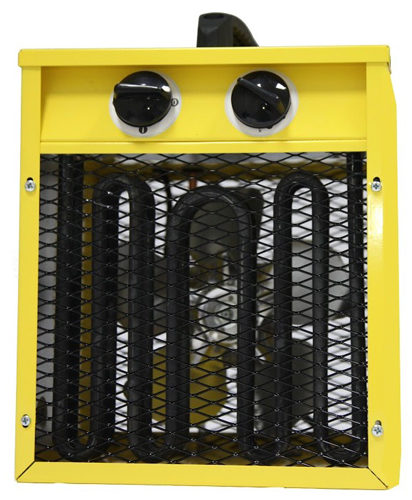
Electric TP of rectangular shape, which makes it easy to install the model on almost any surface. A distinctive feature of the NE device has a long service life. It is achieved by the fact that the manufacturer chose magnesium oxide wrapped in nichrome as a NE. The combination of price and quality allows the EH 3 T to be used in a residential area, a small workshop.
| Model | EH 3 T |
|---|---|
| NE type | Electric |
| Max. Power | 3 kW |
| Heating area | up to 35 sq / m |
| Outgoing air exchange | 500 m³ / hour |
| Control type | Mechanical |
| Dimensions (width, height, depth cm, weight kg) | 25.6x33x24 cm, 5.2 kg |
| Additional functions | Overheating shutdown |
| Thermostat |
Advantages:
- Ease of use;
- Large section wire that is not afraid of chafing, rodents;
- Ergonomic shape;
- Decent, despite the price, quality.
Disadvantages:
- Short cord;
- Inconveniently located controls, labels to them.
Medium power plants
Timberk TIH R2 5K
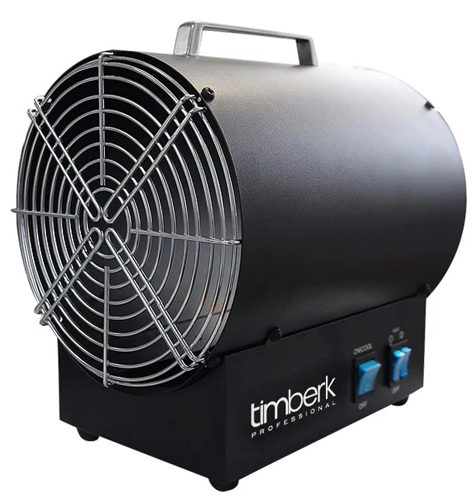
Good performance, high efficiency model that has earned positive recommendations. Small rooms with TIH R2 5K will be too hot. Its purpose is to heat large rooms or those that are constantly exposed to the cold - shops, offices, warehouses. Users note a low noise level, shock-resistant, lightweight plastic case.
| Model | TIH R2 5K |
|---|---|
| NE type | Electric |
| Max. Power | 5 kW |
| Heating area | up to 50 sq / m |
| Outgoing air exchange | 390 m³ / hour |
| Control type | Mechanical |
| Dimensions (width, height, depth cm, weight kg) | 37x23x30 cm, 5.2 kg |
| Additional functions | Fan operation without NE |
| Temperature control, power |
Advantages:
- Light weight with good power;
- Corrosion-resistant housing;
- Several degrees of work.
Disadvantages:
- There is no possibility of adjustment based on the device.
Shivaki SHIF-EL60Y
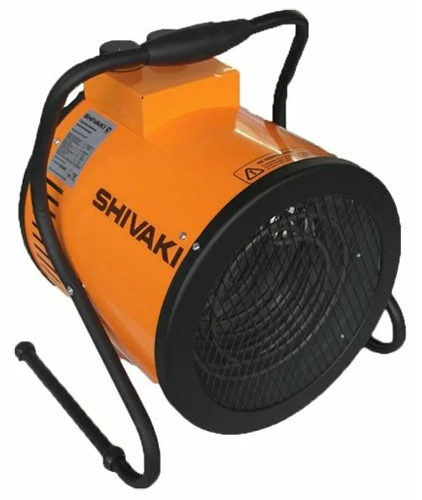
Outwardly attractive system from a well-known Japanese manufacturer. Its attractive sides are the average price, a good resource of the electric motor. Its powerful jet will quickly heat a medium sized utility unit to the optimum temperature. And when it warms up, the power can be reduced from 6 to 4 kW, which will save electricity. It is allowed to work without NE, in blowing mode.
| Model | SHIF-EL60Y |
|---|---|
| NE type | Electric |
| Max. Power | 6 kW |
| Heating area | up to 60 sq / m |
| Outgoing air exchange | 820 m³ / hour |
| Control type | Mechanical |
| Dimensions (width, height, depth cm, weight kg) | 33.5x42x33.5 cm, 7.3 kg |
| Additional functions | Fan operation without NE |
| Power adjustment |
Advantages:
- Double walls of the case;
- Overheating protection;
- Long engine resource;
- Adjustable with stand.
Disadvantages:
- Requires 380 W three-phase network
Ballu BHG-10
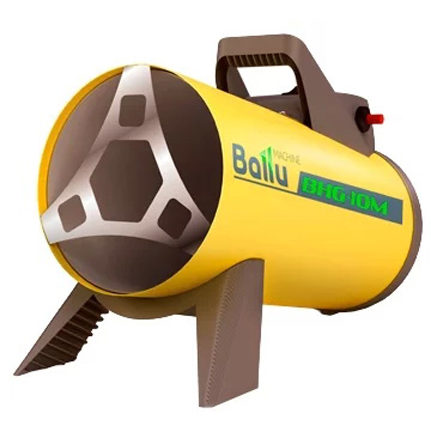
Medium in power, but very economical in terms of fuel consumption, a heater of a well-known company. A distinctive feature of the BHG-10 is stable operation with an uneven supply of electricity. If heating of a large, up to 300 sq. M. Warehouse, workshop is required, and the question of how much heating each square meter is your pressing question, pay attention to BHG-10.
| Model | BHG-10 |
|---|---|
| NE type | Gas |
| Max. Power | 10 kW |
| Heating area | up to 300 sq / m |
| Outgoing air exchange | 270 m³ / hour |
| Control type | Mechanical |
| Dimensions (width, height, depth cm, weight kg) | 22x33x43 cm, 6.3 kg |
| Additional functions | Overheating shutdown |
| Power adjustment |
Advantages:
- High efficiency;
- The presence of a piezo ignition;
- Stopping the gas supply when the flame goes out;
- High level of security;
- The complete set includes a gas reducer.
Disadvantages:
- Powered by propane only.
Industrial plants
MASTER B 100 CED
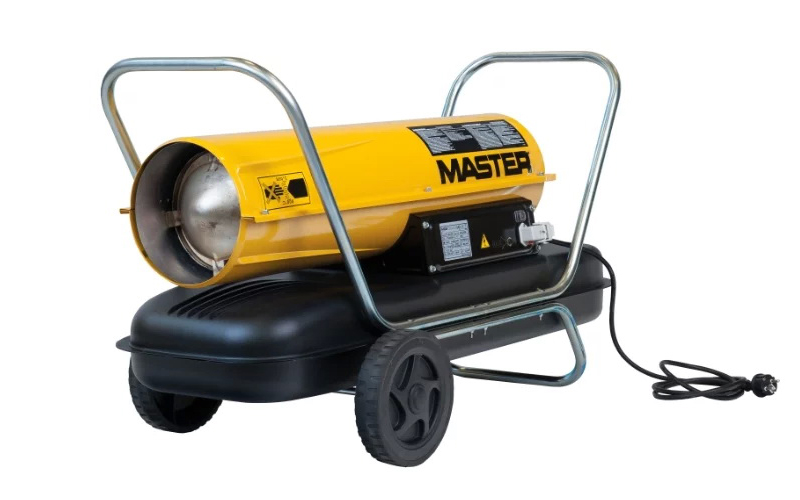
An excellent representative of diesel TP of direct action. The force of the air flow is sufficient to heat an industrial building with a volume of about 700 square meters. The fuel consumption will be about two liters per square meter of area. That, with a 44 liter tank, gives a long heater operation time.
The MASTER B 100 CED has a wheel base for transport. For this reason, the gun is often used on open-type construction and repair sites.
| Model | B 100 CED |
|---|---|
| NE type | Diesel |
| Max. Power | 29 kWt |
| Heating area | up to 700 sq / m |
| Outgoing air exchange | 800 m³ / hour |
| Control type | Mechanical |
| Dimensions (width, height, depth cm, weight kg) | 11,1x40x45 cm, 25 kg |
| Additional functions | Overheating shutdown |
Advantages:
- Decent workmanship;
- Mobility;
- Elementary management.
Disadvantages:
- A common disadvantage of all such devices is air pollution with exhaust gases;
- An optional thermostat is not supplied, you will have to pay extra for it.
Elitech TP 120 DP
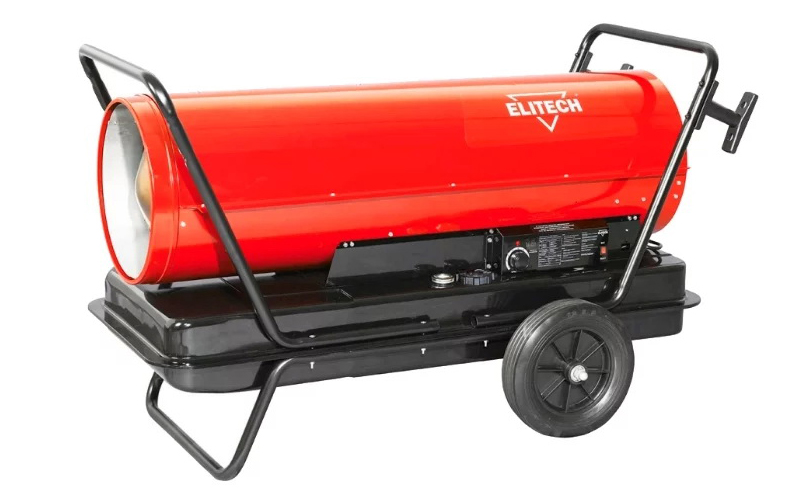
The most powerful heater that rightfully bears the name is a cannon. The maximum possible power is combined with a huge air flow. Elitech TP 120 DP has practically no equals among diesel direct guns. For this you have to pay with the large weight of the device, as much as 75 kilograms, because the tank of the Elitech TP 120 DP is by no means small, as much as 110 liters.
The manufacturer paid special attention to the safety of work, the double casing, the overheating alarm of the device, protection against power surges make the operation of the Elitech TP 120 DP trouble-free. At the same time, there are no special difficulties with control, thanks to the intuitive display interface.
| Model | TP 120 DP |
|---|---|
| NE type | Diesel |
| Max. Power | 120 kWt |
| Heating area | up to 800 sq / m |
| Outgoing air exchange | 2124 m³ / hour |
| Control type | Mechanical |
| Dimensions (width, height, depth cm, weight kg) | 147x65x67.5 cm, 75 kg |
| Additional functions | Overheating sensor and protection |
| Thermostat |
Advantages:
- LCD display;
- High degree of security;
- Plug-in economy mode;
- Possibility of transportation.
Disadvantages:
- Corresponding power dimensions, weight.
Conclusion
Of course, the entire spectrum, even if only the popular heat guns of 2020, cannot be displayed in one article. But we hope we answered most of those interested in how to choose a quality model to their question. If you have your own rating or advice on which one is better to buy a heater, diesel, gas, write in the comments. We would be interested to know your opinion.












